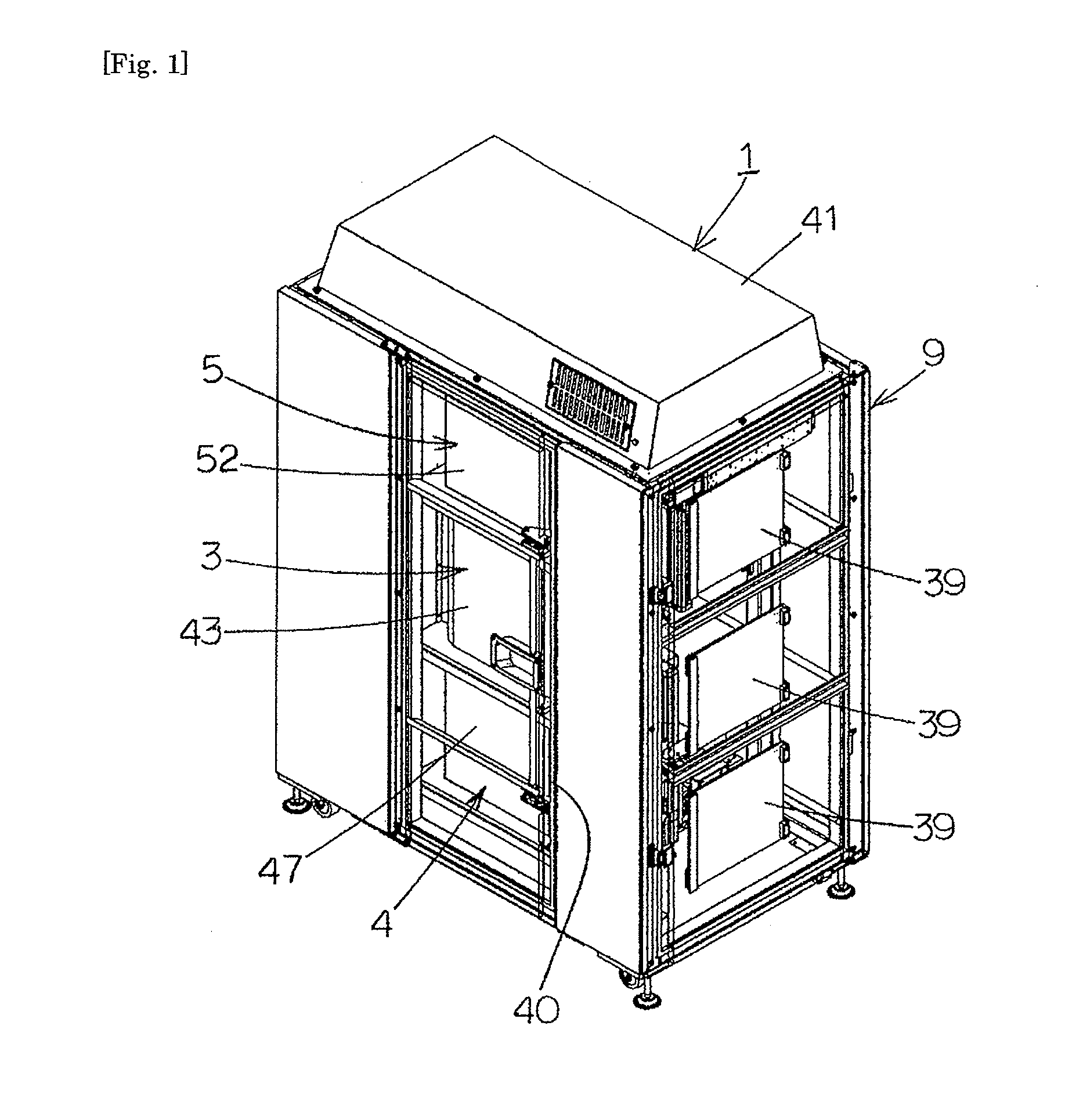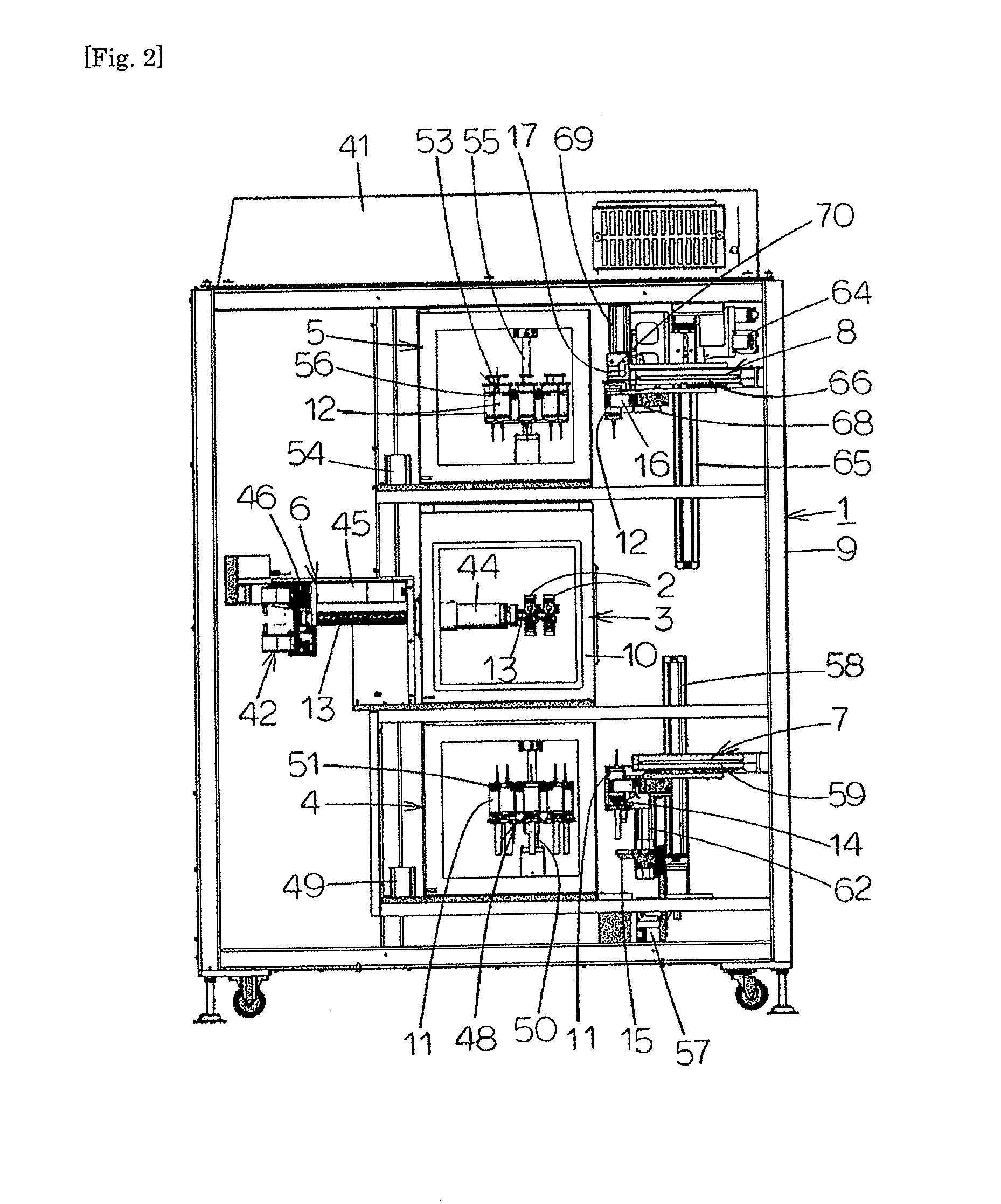[0024]The rotating culture vessel of the present invention as described above includes one or more inlets / outlets for supplying cells and a liquid culture medium at a initial stage and taking out cultured cells at an appropriate position on a flat cylindrical culture container and at least one pair of a supply port and a
discharge port for liquid culture medium exchange on an outer circumferential cylindrical face of the culture container. The pair of the supply port and the discharge port are positioned 180° opposite to each other, the discharge port has a center line passing through a rotating center, and the supply port has a center line eccentrically positioned with respect to the rotating center. Hence, the rotating culture vessel is stopped with the supply port facing downward and the discharge port facing upward, the supply
syringe including a new liquid culture medium is connected to the supply port, while the discharge
syringe is connected to the discharge port, the
piston of the supply
syringe is pushed up to supply the new liquid culture medium into the culture container, and the
piston of the discharge syringe is simultaneously pulled up to suck a used liquid culture medium for liquid culture medium exchange, as well as at the time, gas accumulated in the upper part of the culture container can be sucked with the discharge syringe. The center line of the supply port is eccentrically positioned with respect to the rotating center, hence, even when clumps of cells in culture are settled down to be placed in the lower part of the culture container, disassembling of the clumps of cells due to the flow caused by the supply of the liquid culture medium can be suppressed because the supply port is placed avoiding the clumps of cells. In particular, the effect is increased when the distance between the center line of the supply port and the rotating center is 0.5r to 0.9r where the culture container has a culture space having a
radius of r. The culture container does not have a supply port and a discharge port interrupting the view on the front face, and thus the progress of culture is easily observed.
[0025]Three pairs of the supply ports and the discharge ports are provided on the outer circumferential cylindrical face of the culture container, and thus a liquid culture medium can be exchanged three times. Hence, the culturing can be continued for about two weeks that is a common cell culture period, and the supply port and the discharge port can be newly used for every exchange of a liquid culture medium. Therefore, the occurrence of contamination can be minimized. When the supply ports and the discharge ports are provided at an equal angle interval, the supply port and the discharge port can be readily located at exact positions.
[0026]When each of the supply port and the discharge port has a septum seal structure and each of the supply syringe and the discharge syringe used for liquid culture medium exchange has a leading end with an injection needle that can pass through the septum seal, the passing of the injection needle through the septum seal can achieve airtight connection, and a new liquid culture medium is supplied from the supply syringe while a used liquid culture medium is sucked with the discharge syringe as well as air can be bled with the discharge syringe. Furthermore, when the injection needle is removed from the septum seal, the hole formed with the injection needle is self-repaired to be closed. Thus, the supply port and the discharge port do not require a special structure for switching operation, and the supply port and the discharge port can be downsized. Therefore, the outer circumferential cylindrical face of the culture container can have three pairs of the supply ports and the discharge ports.
[0027]The outer circumferential cylindrical face of the culture container includes the cell suspension supply port for supplying a cell suspension composed of cells and a liquid culture medium, and a front face orthogonal to the rotating shaft of the culture container includes an air bleeding port and a cell discharge port. Hence, the culture container is kept in a horizontal position with the front face facing upward, a cell suspension supply syringe is connected to the cell suspension supply port, an air discharge syringe is connected to the air bleeding port, a cell suspension is supplied from the cell suspension supply syringe, air in the culture container is simultaneously sucked with the air discharge syringe, the air in the culture container is replaced with the cell suspension, and initial culture preparation can be completed. In particular, when each of the cell suspension supply port and the air bleeding port has the septum seal structure, an
insertion of the injection needle of the syringe to the septum seal can simply achieve airtight connection to lead to easy manual operation. The cell discharge port has a rubber plug structure with a large opening, and hence clumps of cells can be readily taken out after culture.
[0028]Each port having the septum seal structure includes the
inlet flow path having a large
diameter for accepting the injection needle behind the septum seal and the orifice flow path having a small
diameter between the
inlet flow path and the culture space of the culture container. Thus, even when the injection needle is inserted into the septum seal at a slightly dislocated position, the injection needle can be accepted into the
inlet flow path, and the supply syringe can supply a liquid culture medium through the orifice flow path into the culture space. Hence, such a structure can minimize the disturbance in the culture space due to the liquid culture medium flow and can suppress the introduction of air remaining in the inlet flow path through the orifice flow path into the culture space in rotation culture. Furthermore, the circumferential face of the culture space has a
small hole of the orifice flow path alone, and thus the liquid culture medium is not disturbed in rotation culture.
[0029]The automatic cell culture apparatus of the present invention is based on the rotation culture technique using RWVs and has the function of automatic liquid culture medium exchange. Thus, such an apparatus can largely reduce burdens of culture operators such as researchers to achieve efficient cell culture as well as can minimize the possibility of contamination in culture. Hence, even medical institutions not having CPC in compliance with GMP can expect clinical application of
regenerative medicine, and consequently, the
regenerative medicine can be greatly generalized. The present invention can completely automate the liquid culture medium exchange operation that has been proven by conventional manual operation in which a new liquid culture medium is supplied into a culture container in a rotating culture vessel from a supply port with a supply syringe and a used liquid culture medium is simultaneously sucked from a discharge port with a discharge syringe. That is, the new liquid culture medium is supplied into the culture space of the rotating culture vessel from the supply port facing downward with the supply syringe, the used liquid culture medium is simultaneously sucked from the discharge port facing upward with the discharge syringe, and concurrently air can be bled. The center line of the supply port is eccentrically positioned with respect to the rotating center, and thus the disassembling of the clumps of cells can be suppressed as described above. The used liquid culture medium sucked in the discharge syringe is stored in the cool discharge box, and hence the contamination can be checked later.
 Login to View More
Login to View More  Login to View More
Login to View More 


